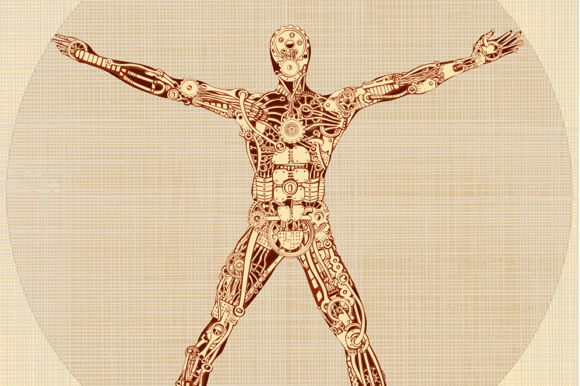To Aubrey de Grey, the body is a machine. Just as a restored classic car can celebrate its hundredth birthday in peak condition, in the future, we’ll maintain our bodies’ cellular components to stave off the diseases of old age and live longer, healthier lives.
Dr. de Grey is cofounder and Chief Science Officer of the SENS Research Foundation and faculty at Singularity University’s November Exponential Medicine conference—an event exploring the healthcare impact of technologies like low-cost genomic sequencing, artificial intelligence, synthetic biology, gene therapy, and more.
Recently speaking to participants in Singularity University’s graduate studies program, de Grey said the greatest challenge in aging research today is less of a technical nature, more a misguided focus in the mainstream.
Most approaches to age-related disease aim to manage symptoms. They have contributed to longer life expectancy and eased complications, but because treatments interfere with the body’s finely tuned systems, they can have nasty side effects and are ultimately powerless (even with advances) to reverse age-related illness. Why?
“Aging is a side effect of being alive in the first place,” says de Grey.
 Metabolic processes drive the day-to-day business of living, but they also inevitably cause cellular damage. The body’s range of self-repair mechanisms don’t take care of everything. Eventually, a lifetime of accumulated damage causes the familiar signs of aging like “thinning skin, cloudy eyes, muscles sapped of strength, heart disease, and cognitive decline.”
Metabolic processes drive the day-to-day business of living, but they also inevitably cause cellular damage. The body’s range of self-repair mechanisms don’t take care of everything. Eventually, a lifetime of accumulated damage causes the familiar signs of aging like “thinning skin, cloudy eyes, muscles sapped of strength, heart disease, and cognitive decline.”
De Grey is known for his research into engineered negligible senescence. Negligible senescence is a term used to describe certain animals that don’t display symptoms of aging. De Grey believes we can use biotechnology to engineer negligible senescence in humans, and he cofounded the SENS Research Foundation to lead the way.
SENS focuses on seven categories of universal damage that contribute to aging.
These seven include cell loss and decreasingly effective cell replacement in the muscles, heart, and brain; uncontrolled cell division (cancer); the accumulation of toxins produced by damaged mitochondria (cellular power plants); the accretion of malfunctioning cells; the stiffening of tissues (like those in our arteries); and the accumulation of extracellular and intracellular junk.
There’s a lot to know about each category, but all have a few things in common—they’re natural byproducts of a body in motion; they’re mostly harmless in small quantities; if left unchecked, accumulated damage results in a range of ailments.

De Grey says we’ve known about the prime culprits of aging for decades, and after years of research, haven’t turned up many more. Now the challenge is using the knowledge to take action.
According to de Grey, there are already generic treatments to address all seven categories of aging either in development or believed to be feasible based on current research.
Examples include stem cell therapies to reverse cell loss and Alzheimer’s drugs to clear amyloid plaques in the brain. Though these areas are well-funded, not all areas attract as much financial backing. De Grey’s organization focuses on neglected areas of research. (Go here for more detail on past and ongoing SENS research initiatives.)
Of course, tackling aging is a massively ambitious cause. But de Grey is a driven individual. A trained computer scientist, he got into the field because age-related illness is universal—a promised suffering that everyone will one day endure.
Along the way, de Grey’s faced his share of controversy.
In 2005, MIT Technology Review placed a $20,000 bounty on papers refuting the scientific merit of SENS. A panel of judges appointed to read submissions concluded none succeeded in disproving de Grey, but neither had de Grey convincingly defended SENS. Rather, as a whole, it remained an intriguing but not fully tested hypothesis.
Mainstream skepticism isn’t terribly surprising.
 Even when research into age-related disease has significant backing and shows promise, progress is slow, and major setbacks are common. Repeated failures in clinical trials of Alzheimer’s drugs to clear amyloid plaques, for example, have been disheartening. While the drugs do get rid of plaques, they haven’t been shown to improve cognitive function or significantly slow decline.
Even when research into age-related disease has significant backing and shows promise, progress is slow, and major setbacks are common. Repeated failures in clinical trials of Alzheimer’s drugs to clear amyloid plaques, for example, have been disheartening. While the drugs do get rid of plaques, they haven’t been shown to improve cognitive function or significantly slow decline.
De Grey says you can’t expect dramatic results by working in only one area—you’ve got to work in them all. For example, in addition to plaques outside cells, Alzheimer’s is also thought to result from intracellular protein debris called tangles. Further, by the time patients exhibit behavioral symptoms, significant fractions of the brain have already died.
Ultimately, SENS has more to prove. But that’s the way of science. Hypothesis is followed by research and evidence. Nathan Myhrvold, former Microsoft CTO and a judge on the Tech Review panel, put it beautifully when he said:
“We need to remember that all hypotheses go through a stage where one or a small number of investigators believe something and others raise doubts…while most radical ideas are in fact wrong, it is a hallmark of the scientific process that it is fair about considering new propositions; every now and then, radical ideas turn out to be true. Indeed, these exceptions are often the most momentous discoveries in science.”
Though de Grey’s foundation has attracted experts in research institutes around the world, the approach has struggled to raise as much funding as they’d like. Funding, not technology has been the biggest bottleneck, according to de Grey.
 But recently, longevity research has seen growing interest and resources dedicated to it. The May 2013 issue of National Geographic with an infant on the cover declared, “This Baby Will Live to Be 120—and It’s Not Just Hype.”
But recently, longevity research has seen growing interest and resources dedicated to it. The May 2013 issue of National Geographic with an infant on the cover declared, “This Baby Will Live to Be 120—and It’s Not Just Hype.”
Others organizations are taking up the cause. Google-funded longevity research firm, Calico, for example, or Craig Venter’s new firm, Human Longevity, Inc. which aims to build a database of tens of thousands of human genomes and their related phenotypes—or the observable characteristics of gene expression in individuals—to discover the genetics of aging.
Eventually, the burden of proof may well reach critical mass, begetting a virtuous cycle of investment and breakthrough. Or maybe aging will prove a persistently difficult nut to crack. De Grey favors the former forecast, and he’s breakthrough-agnostic.
“I’d love to be scooped,” he says.
Within the next three decades, de Grey believes there’s a 50/50 chance we’ll have marshaled the necessary therapies to add 30 years to life expectancy.
As a natural byproduct of these enabling technologies, those extra years ought to be healthier and more active. And that will only be the beginning. Those who live 30 more years will be alive to see additional advances add more years, and so on.
What of the social, economic, and environmental implications of people living dramatically longer lives? De Grey says simply, “I have no idea.” A common error we make worrying about the future is assuming nothing changes between now and then.
No one will be celebrating their 200th birthday for at least a hundred years, and a lot can happen in a century. The best we can do is keep our eyes on the prize. And for de Grey, the prize is clear, “I don’t want us to go on dying the way we always have.”
If de Grey has his way, one day we’ll regularly visit the rejuvenation clinic to “replace, remove, repair, and reinforce” bodily systems damaged by the business of living.
We’ll not only live longer, we’ll do it in style.
Learn from de Grey and other leading experts how emerging technologies will revolutionize medicine and healthcare at Singularity University’s Exponential Medicine conference (San Diego, November 9-12).
Image Credit: Shutterstock.com; Bùi Linh Ngân/Flickr; NIH/National Cancer Institute/Wikimedia Commons




